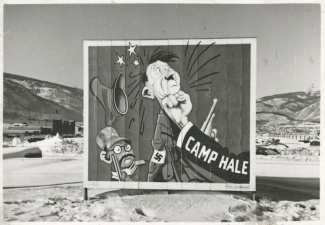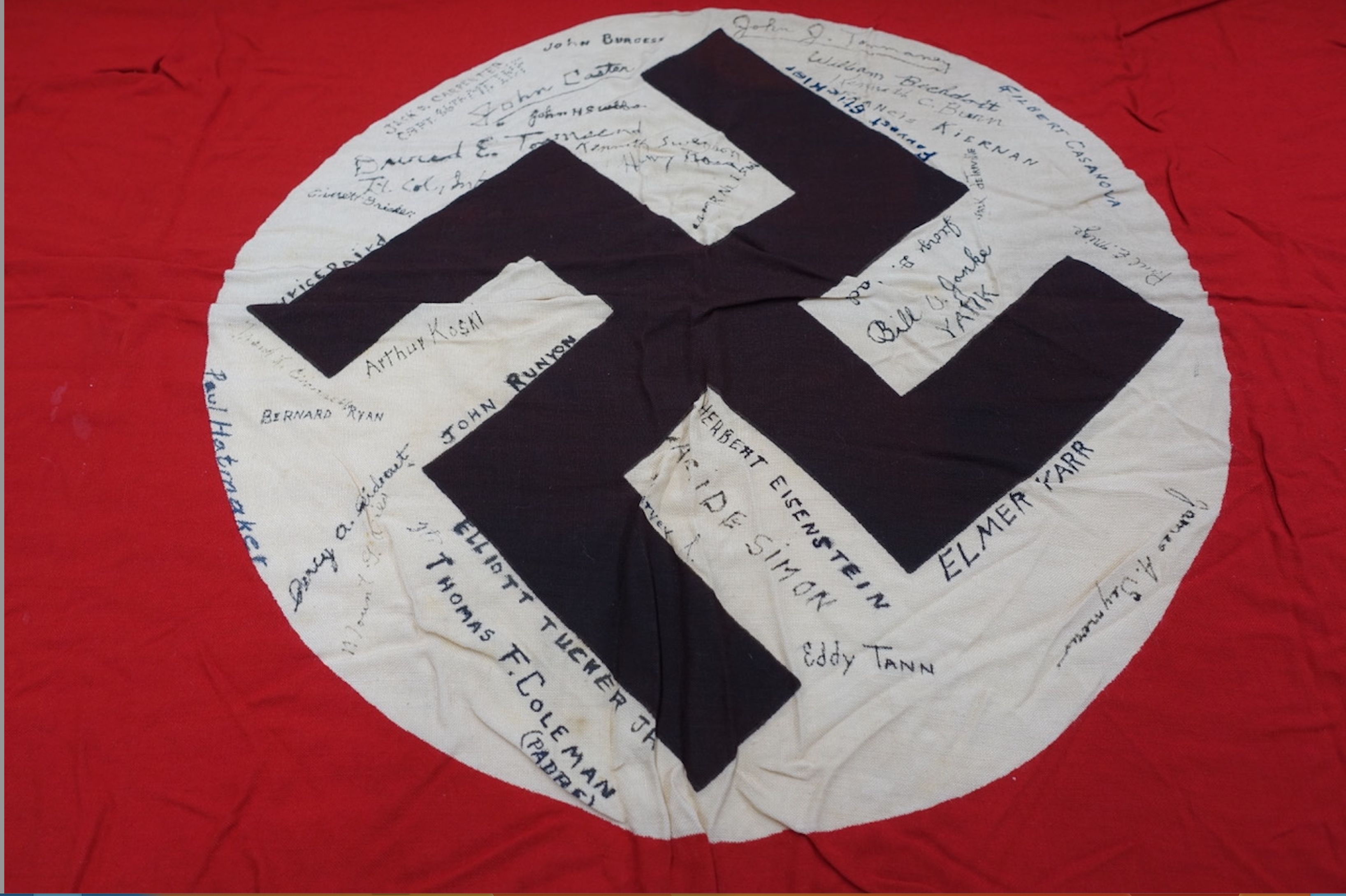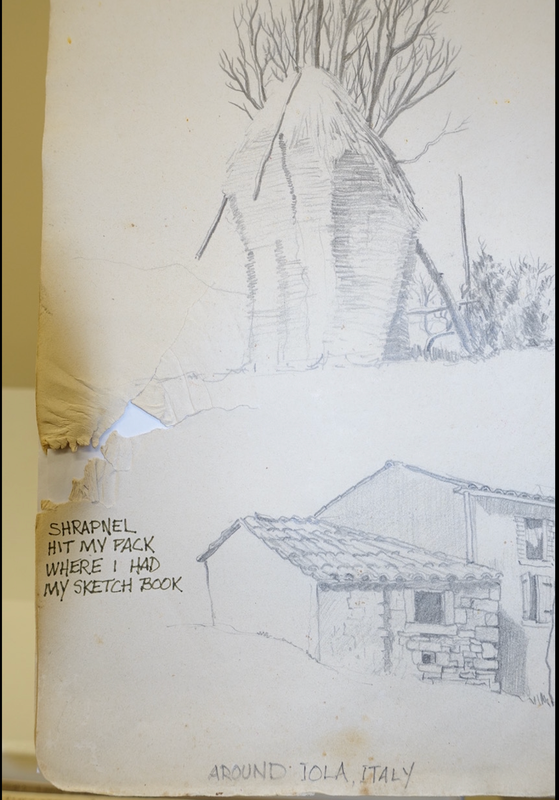Denver Archives Preserve Legacy of the 10th Mountain Division

Denver Public Library hosts hundreds of WWII artifacts.
Photo top courtesy History Colorado, Zellers Collection
In the cavernous, climate-controlled archives of the 10th Mountain Division Resource Center at the Denver Public Library (DPL) lie untold numbers of flat file cabinets. My guide opens one of the drawers, and it takes my breath away. Inside is a large Nazi flag —a swastika—the evil black icon over a white circle on a blood-red field. It’s the ancient religious and cultural symbol that was appropriated by the Nazi party. This flag was captured in war-torn Italy in 1945 by members of the 10th Mountain Division, then signed by many of these ski troops.

The signatures include Eddy Tann, Elliott Tucker Jr, Herbert Eisenstein, Elmer Karr, Arthur Koski, Paul Hatmaker, John Runyon, Thomas F. Coleman and 30 others, all of whom have passed by now. Their names are memorialized by this flag and in the hearts and minds of their descendants.
Just a few steps away, another drawer contains the tattered sketchbook of Arnold C. Holeywell (1923–2010), an artist and mapmaker. The battered book contains a pencil drawing of a simple rock-foundation farmhouse near the village of Iola, Italy. To the left of the sketch, next to a rip in the page, is Holeywell’s simple explanation, almost an apology to future readers for the condition of the notepad: “Shrapnel hit my pack where I had my sketchbook.”

Holeywell became a prominent contributing illustrator for Field and Stream magazine, where his work appeared on several covers. He also produced a series of watercolors for the Ford Motor Company’s publication Ford Times.
When New York’s Whiteface Mountain ski area was dedicated to the men of the 10th Mountain Division, Holeywell arranged to have a large stone quarried from Mount Belvedere, Italy, to serve as a base for a commemorative plaque installed at Little Whiteface Mountain.
Legendary Ski Troops
The 10th Mountain troops—a full division of the U.S. Army specializing in mountain and winter warfare—fought enemy forces in the Italian campaign of 1945. Dubbed the “ski troops” by the press, the 10th Mountain remains the only military division recruited by a civilian organization, the National Ski Patrol.
In February 1945, the 10th, which had arrived on the front several weeks before, launched Operation Encore, an offensive to take Monte della Riva (“Riva Ridge” to the U.S. Army) and Monte Belvedere. They reached Monte Terminale, above Iola, within a few days.
Then on March 3, 1945, the 10th’s 86th Regiment engaged in a fierce battle for the conquest of Iola. This was achieved after violent house-to-house clashes, according to an historical account by the Municipality of Montese, in the province of Modena, Emilia-Romagna, Italy.
An Astounding Collection
The Nazi flag and Holeywell’s sketchbooks are just two of the thousands of items available to the public at the Denver Public Library since the archive was established at the request of veterans in 1987. At that time, the library partnered with the History Colorado Center and the National Association of the 10th Mountain Division to create the 10th Mountain Division Resource Center. The library houses flat ephemera, while the museum, located nearby, houses three-dimensional artifacts, including uniforms, equipment and even a Studebaker M29 Weasel.
The resource center is the official repository for the records and artifacts related to the 32,247 soldiers who served in the 10th, including my late father-in-law. The astounding collection includes material from the National Archives in Maryland plus hundreds of documents, like Holeywell’s sketchbooks, provided by veterans.
Here, you’ll find field and technical manuals; sketches and watercolors by soldiers; motion picture films, videotapes and audio recordings; meeting minutes, reports and historical notes; newspaper clippings; and even a car tag and visitor pass from Camp Hale near Leadville, Colorado.
There’s a German map case, a Japanese flag captured at Kiska and medals, patches and propaganda leaflets and posters, including one particularly egregious example: a painted wood sign from Camp Hale that depicts the unflattering caricature of a Japanese soldier, holding a knife dripping in blood, under the heading, “Let’s Sink the Yellow Bastard.” (The anti-Japanese photo is available online, accompanied by the disclaimer, “Though racist in nature, it represents a theme seen in propaganda on both sides of the Pacific.”) Another sign from Camp Hale shows an unappealing, pointy-nosed image of Adolph Hitler beneath the heading, “We’ve Got a Date with This Sonofabitch. Let’s Be on Time!”
Searching for My Father-in-Law
I had come looking for records of my father-in-law, Arnold Robert Kirbach. Until his death in 2009 at the age of 95—after years of ski teaching at Vermont’s Pico Peak and Killington—he would regale us around the Thanksgiving table about his time as a skiing and rock-climbing instructor at Camp Hale, and about wrestling with the notorious mules at Camp Swift, near Austin, where the 10th underwent infantry training on the hot Texas prairie.

We knew not to get him started about those mules. According to The Boys of Winter, by ISHA board member Charles J. Sanders (University Press of Colorado, 2005), there were 6,000 pack mules, plus dogsled teams and motorized snow-going “weasels” assigned to the 10th.
Keli Schmid, Denver Public Library Special Collections librarian and my host, has a degree in library science from San Jose State University and has been at DPL for eight years. She brings out a legal box crammed with yellow acid-free folders, the personal papers of Charles Minot “Minnie” Dole (1899–1976), best known as the founder of the National Ski Patrol in 1938 and instigator of the American ski troops beginning in 1940.
Within the Dole collection is paperwork showing that my father-in-law was a corporal in Company K of the 86th Infantry. There’s a Western Union telegram confirming he reported for duty on July 13, 1943, to Fort Dix. Never shipped overseas, he remained an instructor until being transferred back to Fort Dix in New Jersey for honorable discharge in December 1944.
Learning more about his military service reinforced for our family what an extraordinary era this was for the Greatest Generation.
The 10th Lives On
Since 2002, the 10th Mountain Division has been the most-deployed regular Army unit. Its combat brigades have seen more than 20 deployments to Iraq and Afghanistan in support of Operation Iraqi Freedom and Operation Enduring Freedom.
The unit’s legacy is not lost on today’s 10th Mountain Division soldiers. New recruits are briefed on the division’s history and participate in a “Powder Keg” patching ceremony to help instill a sense of pride from those who came before, according to a U.S. Army Fort Drum press release dated Jan. 19, 2023. tinyurl.com/TenthPatching)
Sergeant Major Alexis Sprakties of the 10th’s Training and Doctrine Command Band, based in Fort Eustis, Virginia, joined the U.S. Army in 2005 at age 28, inspired by the 9/11 attacks, which occurred about a mile from her New York City home. During a previous stint as first sergeant of the 10th Mountain Division Band in 2020–2022, Sprakties led the remake of the classic 10th song “90 Pounds of Rucksack.” She attended virtual meetings with the descendants of the 10th Mountain Division, whose fathers were part of the WWII–era 10th, and picked their brains on appropriate song selection. The new barbershop quartet–style version includes the updated lyrics, “We’ll climb the mountain like our grandpa used to do.” (tinyurl.com/TenthRemake).
Sprakties adds, “As the 10th Mountain Division prepares to fight in environments similar to those it fought in WWII it must look back and learn from the ‘old climbs’ and channel the strength, grit and humility of the original 10th Mountain Division Soldiers. There is a sense of pride in striving to be ‘Mountain Tough.’” 
Editor’s note: In October 2022, President Joseph R. Biden created Camp Hale as the country’s 130th national monument, protecting for future generations a rugged landscape in the heart of the Rocky Mountains where the legendary 10th Mountain Division trained for Alpine warfare. See Skiing History, November-December 2022.
Jeff Blumenfeld, vice president of ISHA and author of Travel with Purpose: A Field Guide to Voluntourism (Rowman & Littlefield), wrote about John Lawton, inventor of the avalanche transceiver, in the September-October 2023 issue.
Guide to Using the Resource Center
10th Mountain archives and ancestry records are open to the public.
The resource center is open to the public inperson, through prior appointment, or anytime online. Start your search at archives.denverlibrary.org.
Visitors also have access to the library’s Ancestry.com account to use while in the Denver facility. It provides images of the U.S. Federal Census from 1790 forward, the American Genealogical Biographical Index, immigration lists and over 9,000 additional databases.
Use the 10th Mountain Division name lookup index to determine if a person was a member of the 10th Mountain Division and the company or regiment with which he served. history.denverlibrary.org/research-tool/10th-mountain-division-name-lookup-index
Archivists and historians share information about their 10th Mountain collections and the programs they support in an hour-long webinar created in 2021. Also included is information about the 10th Mountain Division Resource Center at the History Colorado Center. tinyurl.com/TenthMt.
As archivist of the 10th Mountain Division Resource Center, Keli Schmid maintains collections and ensures the preservation of materials. “I process new acquisitions, assist with research requests, and I help descendants and historians fill in the stories of individual soldiers and the time they spent with the division.” The best way to contact Schmid is by email at kschmid@denverlibrary.org.
Propaganda posters were frequently used to motivate troops in World War II. These examples were displayed at the 10th Mountain Division’s training center at Camp Hale, Colorado.
I had come looking for records of my father-in-law, Arnold Robert Kirbach. Until his death in 2009 at the age of 95—after years of ski teaching at Vermont’s Pico Peak and Killington—he would regale us around the Thanksgiving table about his time as a skiing and rock-climbing instructor at Camp Hale.
History of the 10th Mountain Patch
According to the U.S. Army press release issued by Fort Drum (Jan. 19, 2023), the original division soldiers adopted an unofficial patch called the “Pando Commando” while training at Camp Hale. It depicted a panda bear skiing down a slope with a rifle slung over its shoulder. The Institute of Heraldry rejected it for being too cartoonish.
On Nov. 6, 1944, the division was redesignated the 10th Mountain Division. Only then were the soldiers authorized to wear the mountain tab and the now iconic shoulder sleeve insignia. The “powder keg” patch features a base in the shape of a gunpowder keg to highlight the explosive power of the division. The crossed bayonets signify the primary infantry role of the division, as well as the Roman numeral “X,” or 10. The design features the crossed bayonets on a field of blue that resembles a powder keg. (tinyurl.com/TenthPatching)
